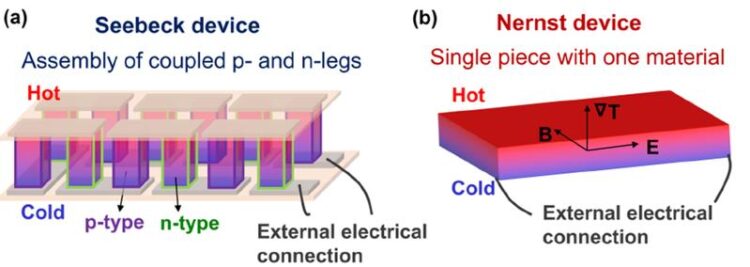A new way to generate electricity from waste heat

Schematics of thermoelectric devices based on the Seebeck effect (a) and Nernst effect (b).
Image: MPI CPfS
– using an antiferromagnet for solid devices.
Researchers at the Max Planck Institute for Chemical Physics of Solids in Dresden, Germany, together with collaborators at the Ohio State University and the University of Cincinnati, have discovered, for the first time, a giant thermoelectric effect in an antiferromagnet.
The study published in Nature Materials in a paper entitled “Giant anomalous Nernst signal in the antiferromagnet YbMnBi2” shows, surprisingly, that antiferromagnets can have the same value of the anomalous Nernst effect as conventional ferromagnets, but without any stray magnetic fields that would otherwise affect surrounding devices. The newly discovered recipe for generating large Nernst voltages opens a new research direction for the development of highly efficient thermoelectric devices.
Forcing electrons to flow perpendicularly to a heat flow requires an external magnetic field – this is known as the Nernst effect. In a permanently magnetized material (a ferromagnet), an anomalous Nernst effect (ANE) exists that can generate electricity from heat even without a magnetic field. The anomalous Nernst effect scales with the magnetic moment of the ferromagnet. An antiferromagnet, with two compensating magnetic sublattices shows no external magnetic moment and no measurable external magnetic field and therefore should not exhibit any ANE.
However, we have recently understood that by the new concept of topology can be applied to achieve large Nernst effects in magnets. In particular, we have learned that the quantity known as the Berry phase is related to the ANE and can greatly increase it. However, the ANE in antiferromagnets is still largely unexplored, in part because the ANE was not thought to exist. Remarkably, a joint research team from the Max Planck Institute for Chemical Physics of Solids in Dresden, Germany, together with collaborators at the Ohio State University and the University of Cincinnati, has found a large anomalous Nernst effect, larger than is known in almost all ferromagnets in YbMnBi2, an antiferromagnet.
The ANE that has been observed is likely a result of topology, the high spin-orbit coupling, and the complex and not fully compensated magnetic structure of YbMnBi2. The canted spin structure in YbMnBi2 breaks time reversal symmetry and provides a non-zero Berry curvature. At the same time, the large spin-orbit coupling of the heavy bismuth element helps to produce a large extrinsic contribution. Based on this recipe, a certain class of antiferromagnets with a non-collinear spin structure and with large spin-orbit coupling can exhibit a large anomalous Nernst effect. The researchers were surprised when they observed such a large ANE in YbMnBi2, reaching 6 V/K, which is a record value for antiferromagnets and as high as those values previously observed for the best ferromagnets.
For practical applications, one could use this new phenomenon to make simple energy converters: a transverse thermoelectric device where the voltage is generated perpendicular to the heat flow. The device consists of only one block of material (figure b). The commercially available thermoelectric generators based on the Seebeck effect are complex assemblies built from small blocks of n- and p-type semiconductor materials (figure a). Unlike ferromagnets, which often suffer from low carrier mobility, antiferromagnets can also exhibit higher mobilities and therefore show better electrical conductivity.
Together with low thermal conductivity, an anomalous thermoelectric figure of merit (zT) is achieved in YbMnBi2, which is an order of magnitude higher than that of all known ferromagnets.
“Although the ANE value is surprisingly large and the zT value is much higher than that of ferromagnets, the overall thermoelectric performance still needs to be improved for practical applications,” says Yu Pan, group leader in the department of Solid State Chemistry at the MPI CPfS in Dresden. She continues, “Nevertheless, this study shows the great potential of antiferromagnets for thermoelectric applications, as they have much better performance than ferromagnets. We believe our work is just the beginning of the discovery of even more interesting thermoelectric materials in the future.”
Wissenschaftliche Ansprechpartner:
Yu.Pan@cpfs.mpg.de
Claudia.Felser@cpfs.mpg.de
Originalpublikation:
DOI https://doi.org/10.1038/s41563-021-01149-2
Weitere Informationen:
Media Contact
All latest news from the category: Life Sciences and Chemistry
Articles and reports from the Life Sciences and chemistry area deal with applied and basic research into modern biology, chemistry and human medicine.
Valuable information can be found on a range of life sciences fields including bacteriology, biochemistry, bionics, bioinformatics, biophysics, biotechnology, genetics, geobotany, human biology, marine biology, microbiology, molecular biology, cellular biology, zoology, bioinorganic chemistry, microchemistry and environmental chemistry.
Newest articles

High-energy-density aqueous battery based on halogen multi-electron transfer
Traditional non-aqueous lithium-ion batteries have a high energy density, but their safety is compromised due to the flammable organic electrolytes they utilize. Aqueous batteries use water as the solvent for…

First-ever combined heart pump and pig kidney transplant
…gives new hope to patient with terminal illness. Surgeons at NYU Langone Health performed the first-ever combined mechanical heart pump and gene-edited pig kidney transplant surgery in a 54-year-old woman…

Biophysics: Testing how well biomarkers work
LMU researchers have developed a method to determine how reliably target proteins can be labeled using super-resolution fluorescence microscopy. Modern microscopy techniques make it possible to examine the inner workings…





















